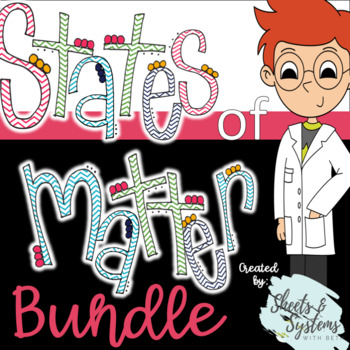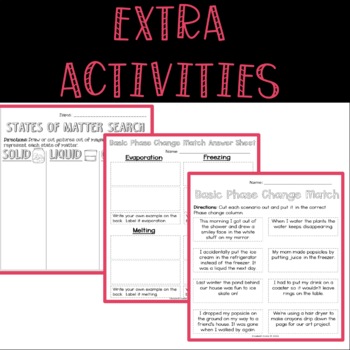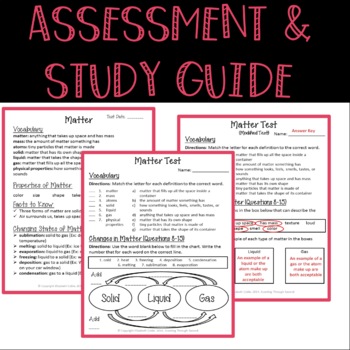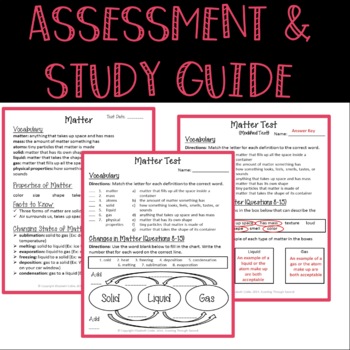States of Matter Bundle (Study Guide, Assessment, Task Cards, & Activities)
- Google Drive™ folder
- Easel Activity

Products in this Bundle (5)
Bonus
Description
Save time and get your students studying at home!
Have a great science unit on Solids, Liquids, and Gases planned but need something students can take home to study each night? Have different ability levels in your classroom and need an assessment that fits those needs? Then this product is for you! Want your students to really prove that they have mastered this topic? This test or quiz makes students write out their knowledge to really show content mastery. Do you have students that really struggle with writing, like ESL or EC students, that you still want to assess and see what they have grasped of the content you've taught? Then this product is exactly what you are looking for!
This study guide has two versions- a regular and modified- making it a very versatile resource. The first version covers the meat of Solids, Liquids, and Gases and the second goes into detail- including phase changes. There are matching study guides for each assessment. These assessments are great for differentiating in second or third grade science classrooms. Use them to enrich or remediate depending on which grade you are teaching. There is also a version of the assessment with and without writing. Want to give a pretest or quiz to see how close your students are to mastery? Use the non-writing version. Then give the one with writing as a summative assessment.
Digital versions of all products are included through Easel or Google Drive. January 2022 a boom card version of the task cards will be uploaded and added to this bundle for free to those who have already purchased it.
MOVE your students to LEARN!
Want your students engaged in their learning? Tired of blank, sleepy faces staring back at you? Then Scoot is your solution! Instead of traditional formative assessments where students stare at a piece of paper- get them up and moving and see who has achieved mastery quickly. Do you have students that you need to pull into small groups to review a skill but nothing for the rest of the class to do? Use Scoot as task cards in your centers to keep your students engaged in their learning.
★Time-Saving
Teachers never have enough time to get it all done! We’re here to help you with that. This resource supplements any Solids, Liquids, and Gases unit saving you the time of having to create an assessment or study guide!
Hearing students excited about the skills you’re teaching will make your day!
★Features
♦ The "Modified" Version (I used in 2nd grade and with my students who are pulled out for EC services in 3rd grade) covers:
•Study Guide
-3 types of matter and their properties
-Pictures of what the atoms in each type of matter look like
-Vocabulary (atom, physical properties, solid, liquid, gas, matter, and mass)
•Test
-No written response on the test
-Matching for the vocabulary
-Circle the properties of matter
-Draw what the three properties of matter look like
♦Full version (used with my regular education 3rd graders) includes:
•Study Guide:
-Vocabulary (solid, liquid, gas, matter, mass, atoms, physical properties)
-Properties of Matter
-Facts to Know
-Changing States of Matter Vocabulary (sublimation, condensation, deposition, melting, freezing, evaporation)
-Changing States of Matter Chart (what happens to matter when you add heat and add cold)
-How matter changes
-Pictorial representation of what the three states of matter look like
Paper, Google Drive, and Easel versions of the assessment are included.
♦Scoot Task Cards
-1 set of 24 Questions Cards
-Color version of the cards (4 cards per page)
-Black & White version of the cards (4 per page)
-Super Ink Saver version (8 cards per page- Black and White with no border)
-Student Answer Sheet
-Answer key for each set of cards
-Exit Slip (3, 2, 1 style formative assessment)
-Directions on how to play and set up the game
-Tips on how I implement this game into my classroom
-Google Drive version of cards
-Easel Version of Cards
♦BOOM Digital Task Cards
-1 set of 24 Boom Cards
-Same questions as the paper task cards but they are:
-Self-grading
-All answers are multiple-choice
♦Extra Freebies
-States of Matter Sorting Activity - paper and digital
-States of Matter Matching Activity (answer key included) - paper and digital
*****************************************************************************
★Common Core Standards
2nd Grade
•K.P.2 Understand how objects are described based on their physical properties and how they are used.
•K.P.2.1 Classify objects by observable physical properties (including size, color, shape, texture, weight, and flexibility).
•K.P.2.2 Compare the observable physical properties of different kinds of materials (clay, wood, cloth, paper, etc) from which objects are made and how they are used.
3rd Grade
•3.P.2 Understand the structure and properties of matter before and after they undergo a change.
•3.P.2.1 Recognize that air is a substance that surrounds us, takes up space and has mass.
•3.P.2.2 Compare solids, liquids, and gases based on their basic properties.
•3.P.2.3 Summarize changes that occur to the observable properties of materials when different degrees of heat are applied to them, such as melting ice or ice cream, boiling water or an egg, or freezing water.
*****************************************************************************
More Science Products You Might Like
States of Matter Scoot {Task Cards}
*****************************************************************************
Customer Tips:
How to get TPT credit to use on future purchases:
• Please go to your My Purchases page (you may need to log in). Beside each purchase, you'll see a Provide Feedback button. Simply click it and you will be taken to a page where you can give a quick rating and leave a short comment for the product. Each time you give feedback, TPT gives you feedback credits that you use to lower the cost of your future purchases. I value your feedback greatly as it helps me determine which products are most valuable for your classroom so I can create more for you. ☺
Be the first to know about my new discounts, freebies, and product launches:
• Look for the green star next to my store logo and click it to become a follower. Voila! You will now receive email updates about this store. ☺
*****************************************************************************
Beth Coble
Sheets & Systems
Beth@sheetsandsystemswithbeth.com





